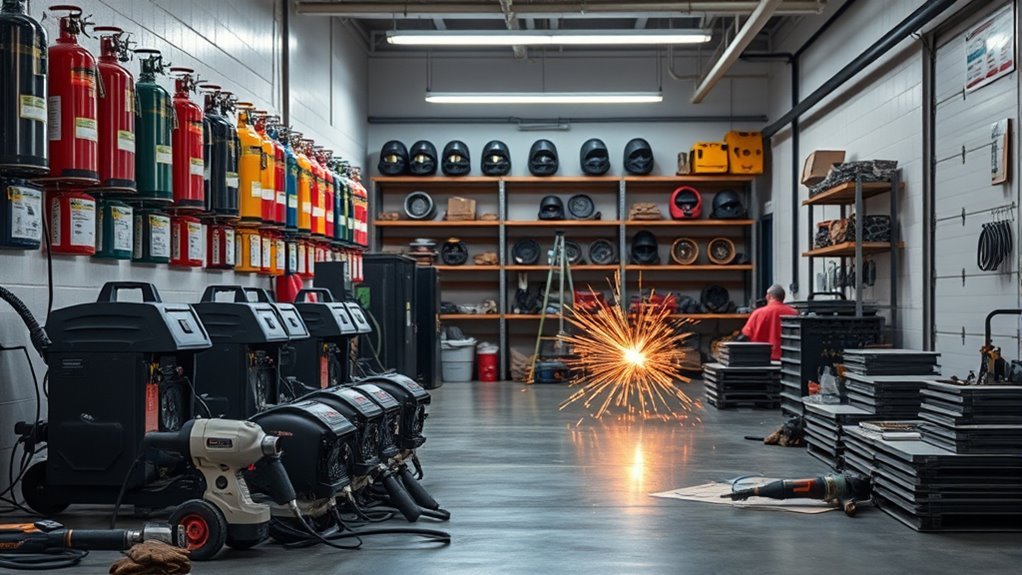You can expect to pay roughly $3,000–$15,000 to start welding classes, depending on program length and school type. Short certificates run a few weeks to months and cost $3,000–$10,000. Community college and two-year programs tend to be $5,000–$15,000, while private trade schools or associate degrees can exceed $20,000. Add $500–$2,000 for tools and gear, plus $300–$550 for certification. Keep reading for breakdowns, aid options, and ROI tips.
Average Tuition Costs for Welding Programs

Expect to pay anywhere from about $5,000 to $15,000 for most welding programs, though advanced or private trade schools can push tuition past $20,000.
You should use tuition comparisons to choose a program that fits your budget: community colleges often run near $5,000 for two-year programs, trade schools range higher, and short certificate options cost $3,000–$10,000.
Don’t forget add-ons—tools, safety gear, and materials can total $100–$2,000, and certification or living costs will raise your outlay.
For clear financial planning, list tuition, supplies, living expenses, and testing fees separately, then compare total costs across programs.
That lets you pick the most cost-effective path to gainful welding skills.
Types of Schools and How Pricing Differs

Anyone can find a welding program that fits their timeline and budget by comparing school types: community colleges tend to be the most affordable—about $5,000 for two-year programs with general education included—while trade schools focus on hands-on, accelerated training and usually charge $5,000–$30,000.
Compare school types to match budget and timeline: community colleges (~$5k) for broader two-year programs, trade schools $5–30k.
Short certificate courses run $3,000–$10,000 for weeks to months of instruction. Specialized tracks like underwater welding often top $15,000 because of equipment and safety needs, and online options can cost as little as $200 up to $4,000 for flexible, remote instruction.
When you compare options, focus on cost, outcomes and program accreditation. Consider:
- Community colleges — lower cost, broader curriculum, recognized credits.
- Trade schools — intensive hands-on practice, higher tuition, faster entry.
- Certificates/online — quick, variable quality; verify accreditation and shop for transparent fees.
Program Lengths and What They Cost

If you need a quick entry path, certificate programs run from a few weeks to a few months and typically cost $3,000–$10,000.
If you want more credentials and broader training, associate degrees take about two years and usually range from $10,000–$25,000 in tuition.
Compare program length, hands-on hours, and included fees to decide which fits your timeline and budget.
Certificate Program Costs
Certificate welding programs typically run from a few weeks to several months and cost anywhere from about $3,000 to $10,000, depending on the school and curriculum.
You’ll want to compare welding certification costs and available financial aid options before enrolling. Community colleges average about $5,000 and may include basic academic courses; trade schools focus on hands-on training and can charge more.
- Choose a program length that fits your schedule—short bootcamps cost less upfront but offer less depth.
- Budget for extras: safety gear ($100–$500) and required tools ($500–$2,000) increase total cost.
- Shop schools for equipment packages, scholarship opportunities, and payment plans to lower immediate outlay.
Associate Degree Expenses
Because an associate degree in welding usually spans two years, you should plan for both tuition and living costs over that period. Tuition generally runs $10,000–$25,000; add living expenses of $5,000–$15,000 per academic year.
Budget $500–$2,000 for tools and safety gear plus $100–$500 for textbooks. Some programs include certification courses with exam fees of $300–$550.
Community colleges combine general education with hands-on welding training, which enhances welding program benefits by broadening skills and credentials. That broader curriculum can improve job placement opportunities, especially when colleges provide career services or industry ties.
Total two-year costs consequently vary widely; create a clear budget covering tuition, materials, certification fees, and living expenses before enrolling.
Tools, Equipment, and Supply Expenses

When you start welding classes, plan on spending anywhere from about $500 to $1,500 for the basic tools and gear, with costs rising if you opt for higher-end equipment.
You’ll prioritize welding safety and routine equipment maintenance to protect yourself and extend gear life.
Budget items include helmets, gloves, jackets and boots (each $100–$500), plus consumables like wire and tips. A practice welder can add $500–$2,000 to your startup cost. Certification tests often cost $300–$550 and may be extra.
- Personal protective gear: buy quality helmets and apparel, inspect and clean regularly.
- Machine and tools: choose based on class requirements; plan for maintenance.
- Consumables and fees: stock wire, tips, and test fees.
Housing and Living Costs During Training

As you plan for welding school, budget for on-campus housing or compare off-campus rent estimates—expect anywhere from about $5,000 to $15,000 per academic year depending on location and accommodation.
Don’t forget daily living expenses like food, transportation, utilities and internet, which can add a few hundred dollars per month.
Look into shared housing, campus options, and scholarships or grants to lower your out-of-pocket costs.
On-Campus Housing Costs
If you’ll live on campus during welding school, expect room and board to add a substantial sum to your budget — typically between $5,000 and $15,000 per academic year depending on the school and location.
You should factor in food, campus transit, and personal expenses so the sticker price isn’t surprising. Look for community colleges that offer affordable housing and ask about housing assistance or aid packages.
- Compare on-campus rates, meal plans, and included utilities to calculate a true annual cost.
- Ask admissions or financial aid about scholarships, emergency grants, or housing assistance that can lower your net expense.
- Plan a monthly budget that includes room, board, transport, supplies, and a small contingency to avoid shortfalls.
Off-Campus Rent Estimates
Because off-campus housing varies by city and unit type, you should budget carefully: expect rent from about $500 to $1,500 per month and another $300–$800 for food, utilities, and transport, which adds up to roughly $5,000–$15,000 per academic year.
You’ll want to explore affordable options like shared apartments, rooms in private homes, or student-oriented rentals near campus. Prioritize housing proximity to the welding school to reduce commute time and transit costs — shorter trips can save money and energy during intensive lab days.
Compare listings, factor in utilities and parking, and ask about lease flexibility for program length. If you attend a community college, look slightly off-campus where rent often drops yet housing proximity still keeps your schedule manageable.
Daily Living Expenses
Living costs during welding training can add $5,000–$15,000 to your annual budget, so plan for rent, food, transportation, and personal items up front.
You’ll usually cover housing separately from tuition, so use budgeting tips to estimate realistic monthly outlays and spot gaps. Research local housing, consider roommates, and track variable expenses to stay on target.
- Rent and utilities: factor room and board if you move away; shared housing cuts per-person cost.
- Food and personal: cook when you can and track groceries to apply cost saving strategies.
- Transportation and incidentals: budget for gas, transit passes, tools, and unexpected repairs.
Be proactive: compare options, set a monthly cap, and adjust as you learn real costs.
Certification and Testing Fees to Budget For
Plan on paying roughly $300 to $550 per certification test, since many programs don’t include exam fees in tuition and you’ll often need multiple or recurring exams for different specialties.
Factor certification requirements into your budget early: some specialties demand specific joint types, positions, or material tests that add fees.
Check testing frequency for each credential — certain employers or cert bodies require periodic retesting or renewal exams, which multiplies costs over your career.
Schools like MTI may offer on-site exams but still charge for each attempt.
Professional bodies such as the American Welding Society also bill for exams and recertification.
Research exact prices for your chosen specialty, schedule tests wisely, and set aside a contingency for retakes.
Financial Aid, Scholarships, and VA/WIOA Assistance
Certification and testing costs can add up fast, so you’ll want to look into financial aid and scholarships that lower your out‑of‑pocket expenses.
Federal financial aid options like grants and low‑interest loans can cut tuition substantially; fill FAFSA early and compare award packages. Community colleges often list grants and scholarship opportunities for new students, so check school pages and deadlines.
Veterans should evaluate the GI Bill® benefits for welding programs, and WIOA can cover training for eligible jobseekers.
- Search professional associations and trade schools for scholarship opportunities tied to competitions or merit.
- Contact your college’s financial aid office to combine grants, loans, and scholarships efficiently.
- Apply to WIOA and VA programs early; they require documentation and approval time.
Payment Plans, Loans, and Alternative Financing
If you can’t pay tuition up front, many schools let you spread costs across multiple installments—often in 7- or 10-week segments—so you can manage cash flow while you train. You should compare payment options: school plans, federal loans (if the program qualifies), private loans, scholarships, and grants. Federal loans often have lower rates and flexible repayment; private loans may require a hard credit pull. Factor in tools ($500–$2,000) and certification fees ($300–$550) when doing financial planning. Ask the school about enrollment in federal aid programs and scholarship deadlines before committing.
| Option | Key points |
|---|---|
| School payment plan | No credit check, set installments |
| Federal loan | Lower rates, eligibility varies |
| Private loan | Faster, credit required |
| Scholarships/grants | Reduces costs, apply early |
Calculating Return on Investment for Welding School
Now that you’ve reviewed financing options, it’s time to measure what you’ll get back for the money you put in.
Calculate ROI by comparing total cost (tuition $5,000–$30,000 plus $300–$550 certification fees) against projected earnings and time to break even. Use median wage data and local industry demand to refine estimates.
Calculate ROI by comparing total costs (tuition $5K–$30K, $300–$550 certs) to projected earnings and local demand.
- Estimate earnings: start with the $47,540 median, then adjust upward for specialized industries (oil, gas, aerospace) where welding job opportunities pay more.
- Include placement: factor school job-placement rates to shorten unemployment gaps and accelerate payback.
- Run scenarios: best, average, worst — include certification, tools, and living costs to find realistic payback years.
Frequently Asked Questions
Are There Prerequisite Classes Required Before Enrolling in Welding Programs?
Yes — you’ll often need basic welding prerequisites like high school diploma or GED, math and safety modules, and sometimes reading/lab skills; program requirements vary by school, so check specific curriculum and placement testing policies.
Is Workplace Safety Insurance Included During Training?
Usually no—you’ll need to confirm with the program: many schools cover basic safety regulations and provide institutional insurance coverage during supervised training, but you’ll often be responsible for personal coverage and liability when offsite or during externships.
Can Employers Reimburse Tuition After Job Placement?
Yes — employers can reimburse tuition after job placement, and you won’t always wait forever. With employer support, you’ll follow reimbursement policies, meet service or performance requirements, submit receipts, and comply with tax and repayment clauses.
Are Weekend or Evening Welding Classes Available?
Yes — you can find weekend and evening welding classes. Many schools offer flexible welding schedules and class flexibility to accommodate work or family obligations, so you can enroll in part-time, evening, or weekend sessions that fit your timetable.
What Are Ongoing Maintenance Costs for Personal Welding Tools?
Like a heartbeat, your ongoing maintenance costs average $100–$400 yearly: you’ll pay for tool maintenance supplies, consumables, occasional equipment upgrades, replacement parts, calibration, and safety gear, keeping performance reliable and downtime minimal.
Conclusion
By now you’ve seen the costs: tuition, tools, living, and cert fees add up, but financial aid and payment plans can chip away at the total. Think of the investment like buying a reliable tool—you’re paying for future earnings and stability. Compare program lengths, school types, and certification outcomes to pick the most cost-effective path. With clear budgeting and available assistance, you can start welding without breaking the bank or burning daylight.


